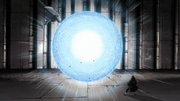No edit summary |
mNo edit summary Tag: sourceedit |
||
| (20 intermediate revisions by 15 users not shown) | |||
| Line 1: | Line 1: | ||
| − | [[File: |
+ | [[File:Ultra-Big Ball Rasengan.png|thumb|right|An example of shape manipulation.]] |
| − | {{translation|'''Shape |
+ | <section begin=summary />{{translation|'''Shape transformation'''|形態変化|Keitai Henka|engtv=Change in Chakra Form}} is an advanced form of [[chakra control]] that involves changing the form and movement of [[chakra]], determining the size, range, and purpose of a [[technique]].<section end=summary /> |
| − | The ultimate example of shape manipulation is the [[Rasengan]], which is described as shape manipulation that has been taken " |
+ | The ultimate example of shape manipulation is the [[Rasengan]], which is described as shape manipulation that has been taken "to the highest possible level".<ref>Chapter 321, page 10</ref> The Rasengan relies heavily on chakra control and does not require the use of [[hand seals]]. By building up on precepts learned from the [[Tree Climbing Practice]] and [[Water Surface Walking Practice]] chakra control exercises, the Rasengan is chakra that has been rotated and then compressed into the shape of a sphere. |
| ⚫ | Shape transformation is one of two necessary components for creating or modifying a technique, the second component being [[nature transformation]]. While shape transformation changes the form and movement of chakra, nature transformation changes the actual nature of the chakra, altering its properties and characteristics. Because of this, a technique like the Rasengan can be turned into the [[Wind Release: Rasengan]] or [[Wind Release: Rasenshuriken]]. The cutting nature of [[Wind Release]], combined with the spiralling movement of chakra, can change the chakra into millions of minuscule blades in a spiralling formation. |
||
| − | == Combining with Nature Transformation == |
||
| ⚫ | Shape |
||
| + | [[Jinchūriki]], when transforming through their progressive forms into their [[tailed beast]], have their chakra moulded around them to resemble the shape of their tailed beast.<ref>Chapter 295, page 3</ref> Through further transformations, the tailed beast chakra can materialise into the flesh and bone of the tailed beast.<ref>Chapter 437, pages 15-17</ref> |
||
| − | [[Sasuke Uchiha]] has also been seen using Shape and Nature manipulation with the black flames from [[Amaterasu]] to create the [[Blaze Release]] and the various techniques he uses that are derived from [[Chidori]]. |
||
== References == |
== References == |
||
<references/> |
<references/> |
||
| − | |||
[[Category:Chakra]] |
[[Category:Chakra]] |
||
| + | |||
| + | [[ka:ფორმის გარდასახვა]] |
||
Revision as of 19:39, 6 May 2015

An example of shape manipulation.
Shape transformation (形態変化, Keitai Henka, English TV: Change in Chakra Form) is an advanced form of chakra control that involves changing the form and movement of chakra, determining the size, range, and purpose of a technique.
The ultimate example of shape manipulation is the Rasengan, which is described as shape manipulation that has been taken "to the highest possible level".[1] The Rasengan relies heavily on chakra control and does not require the use of hand seals. By building up on precepts learned from the Tree Climbing Practice and Water Surface Walking Practice chakra control exercises, the Rasengan is chakra that has been rotated and then compressed into the shape of a sphere.
Shape transformation is one of two necessary components for creating or modifying a technique, the second component being nature transformation. While shape transformation changes the form and movement of chakra, nature transformation changes the actual nature of the chakra, altering its properties and characteristics. Because of this, a technique like the Rasengan can be turned into the Wind Release: Rasengan or Wind Release: Rasenshuriken. The cutting nature of Wind Release, combined with the spiralling movement of chakra, can change the chakra into millions of minuscule blades in a spiralling formation.
Jinchūriki, when transforming through their progressive forms into their tailed beast, have their chakra moulded around them to resemble the shape of their tailed beast.[2] Through further transformations, the tailed beast chakra can materialise into the flesh and bone of the tailed beast.[3]
